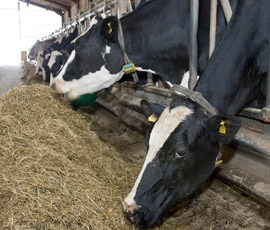Protein price fall spells buying opportunities

As protein prices fall now’s the time to buy, says KW’s James Butt-Evans
Recent weakening of the soya bean meal market has produced the best buying opportunity for some time, and it’s important that any livestock farmer without cover for the rest of the winter acts quickly.
With the underlying balance of supply and demand remaining extremely tight, the expectation is that prices could well rise again before Christmas.
This short-term turnaround followed a surprise announcement from the United States Department of Agriculture (USDA) indicating that North American soya bean yields are even higher than expected. With harvest now 96% complete, the prediction that the crop will total about 80.9 million tonnes was enough to inject some immediate relief into the market.
The focus had been switching to South American plantings in recent weeks as the US harvest came to an end, but this unexpected news from the USDA saw that focus shift back to the improved supply from North America. This was coupled with reports that China had cancelled 10 cargoes of US soya beans as a result of falling crush margins and weak domestic demand.
But it’s not all been good news. China has been back in the market securing forward contracts, and although conditions are generally favourable in Brazil, heavy rains are holding up soya bean planting in Argentina. Planting is about 11% complete, and the market will undoubtedly re-focus on the South American crop very shortly.
A bumper crop is needed to provide longer term relief, and that requires good conditions throughout the rest of planting and crop emergence, and an increase in acreage. The potential for adverse weather to delay or damage the crop makes it entirely feasible that prices could rise again before the end of 2012.
The situation isn’t helped by the supply of domestic rapemeal being severely limited, with UK crushers virtually sold out for the November to January period and any additional demand now being met using imported material. This has pushed prices higher at a time when soya bean meal prices have dropped, making rapemeal compare less favourably for the first time in quite a while.
Demand does remain strong, however, which will keep those nearby prices firm. In comparison, summer prices have fallen in line with soya bean meal, resulting in significant interest in buying forward, both for rapemeal and UK-produced bioethanol wheat distillers’ feed.
Compared to the price of wheat and other proteins, domestic wheat distillers’ feeds are looking to be good value once supplies increase. At present, it’s only imported material that’s available, and this looks expensive compared to the material expected from the Vivergo and Ensus bioethanol plants in the coming months.
Just remember that the high demand still remaining for proteins will likely prevent any significant reduction in prices despite the additional volumes. Securing summer contracts should be given serious consideration while prices look competitive and availability isn’t an issue.
Wheat prices continue to remain firm, and although there’s been some considerable market volatility during the last week or so, wheat remains above £200/t at the time of writing. Domestic wheat is in plentiful supply for delivery pre-Christmas, with merchants keen to shift some volume and reduce storage costs, but this situation is unlikely to remain once into 2013.
EU exports are strong – Brussels granted 695,000t of export licences in one recent week – and although the Ukrainian export ban for the second half of November has been withdrawn, the talk is it will now start on 1 December. Overall, the worldwide supply of cereals looks tight, with the UK very much in the same position, particularly given ongoing quality issues.
For digestible fibre, soya hulls continue to trade at a significant discount to sugar beet feed for the winter, and are an extremely good buy for the summer. In contrast, the supply of discounted wheat feed has now dried up – sellers have realised that the price was probably too low, and availability until January to February is now becoming limited.
The situation is also difficult for those requiring additional starch, with SweetStarch, for example, increasing in price in response to both the firm cereal market and strong demand. The various confectionery blends remain better value than cereals for energy, as do the liquid feeds, but even the availability of some of these is now dropping off.
If you haven’t already booked alternative energy feed requirements for the rest of the winter, take care you don’t get caught out by lack of availability whilst waiting for a better price. And for cereals, book perhaps a couple of months ahead to avoid problems of supply around the Christmas period, then watch closely to see how the market reacts to the reduced global supply once into 2013.
| Feed markets at a glance | ||
|---|---|---|
| Soya beans | Rapemeal | Energy feeds |
|
|
|
Read more articles from our Feed Watch series
